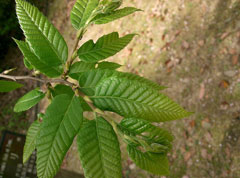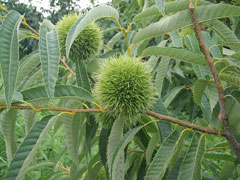 |
|
http://commons.wikimedia.org/wiki/User:KENPEI |
 |
| http://commons.wikimedia.org/wiki/User:Apple2000 |
Translate this page:
Summary
Physical Characteristics

 Castanea crenata is a deciduous Tree growing to 9 m (29ft 6in).
Castanea crenata is a deciduous Tree growing to 9 m (29ft 6in).
See above for USDA hardiness. It is hardy to UK zone 4. It is in flower in July, and the seeds ripen in October. The species is monoecious (individual flowers are either male or female, but both sexes can be found on the same plant) and is pollinated by Insects.
Suitable for: light (sandy), medium (loamy) and heavy (clay) soils, prefers well-drained soil and can grow in nutritionally poor soil. Suitable pH: mildly acid and neutral soils and can grow in very acid soils.
It can grow in semi-shade (light woodland) or no shade. It prefers dry or moist soil and can tolerate drought.
UK Hardiness Map
US Hardiness Map
Synonyms
C. japonica.
Plant Habitats
Woodland Garden Canopy;
Edible Uses
Edible Parts: Seed
Edible Uses:
Seed - raw or cooked[1, 46, 61]. A good potato substitute[63, 105, 142, 171]. A source of starch[177]. Very poor flavour[142]. Coarse and of little value. Very variable in size and quality, any astringency can be removed by boiling the seed in salty water[183].
References More on Edible Uses
Medicinal Uses
Plants For A Future can not take any responsibility for any adverse effects from the use of plants. Always seek advice from a professional before using a plant medicinally.
None known
References More on Medicinal Uses
The Bookshop: Edible Plant Books
Our Latest books on Perennial Plants For Food Forests and Permaculture Gardens in paperback or digital formats.

Edible Tropical Plants
Food Forest Plants for Hotter Conditions: 250+ Plants For Tropical Food Forests & Permaculture Gardens.
More

Edible Temperate Plants
Plants for Your Food Forest: 500 Plants for Temperate Food Forests & Permaculture Gardens.
More

More Books
PFAF have eight books available in paperback and digital formats. Browse the shop for more information.
Shop Now
Other Uses
Tannin Wood
The bark, leaves, wood and seed husks all contain tannin. Wood - hard, strong, light, very durable. Used for furniture, construction, fence posts etc[46, 61].
Special Uses
Carbon Farming
References More on Other Uses
Cultivation details
Industrial Crop: Tannin Management: Standard Regional Crop Staple Crop: Balanced carb
Prefers a good well-drained slightly acid loam but succeeds in dry soils[1, 11, 200]. Once established, it is very drought tolerant[1, 11, 200]. Very tolerant of highly acid, infertile dry sands[200]. Averse to calcareous soils but succeeds on harder limestones[11, 200]. The majority of species in this genus only really thrive in areas with hot summers, though this species is better adapted to British conditions than most[200]. Cultivated for its edible seed in Japan, there are many named varieties[58, 63, 183]. It is often also cultivated for its seed in America because it is fairly resistant to chestnut blight[171, 200]. Individual trees are very variable with regard to size of the seed, resistance to blight and astringency of the seed[183]. Some cultivars have the largest seeds of any member of this genus. Trees fruit freely when only 3 - 3.5 metres tall[11]. This species is occasionally planted as a timber tree in S. Europe[50]. An excellent soil-enriching understorey in pine forests[200]. Flowers are produced on wood of the current year's growth[229]. Plants are fairly self-sterile[200]. They hybridize freely with other members of this genus[200]. Plants in this genus are notably resistant to honey fungus[200].
Carbon Farming
-
Industrial Crop: Tannin
Occur generally in the roots, wood, bark, leaves, and fruit of many plants. Used in tanning leather, dyeing fabric, making ink, and medical applications.
-
Management: Standard
Plants grow to their standard height. Harvest fruit, seeds, or other products. Non-Destructive management systems.
-
Regional Crop
These crops have been domesticated and cultivated regionally but have not been adopted elsewhere and are typically not traded globally, Examples in this broad category include perennial cottons and many nuts and staple fruits.
-
Staple Crop: Balanced carb
(0-15 percent protein, 0-15 percent oil, with at least one over 5 percent). The carbohydrates are from either starch or sugar. Annuals include maize, wheat, rice, and potato. Perennials include chestnuts, carob, perennial fruits, nuts, cereals, pseudocereals, woody pods, and acorns.
References Carbon Farming Information and Carbon Sequestration Information
Temperature Converter
Type a value in the Celsius field to convert the value to Fahrenheit:
Fahrenheit:
The PFAF Bookshop
Plants For A Future have a number of books available in paperback and digital form. Book titles include Edible Plants, Edible Perennials, Edible Trees,Edible Shrubs, Woodland Gardening, and Temperate Food Forest Plants. Our new book is Food Forest Plants For Hotter Conditions (Tropical and Sub-Tropical).
Shop Now
Plant Propagation
Seed - where possible sow the seed as soon as it is ripe in a cold frame or in a seed bed outdoors[78]. The seed must be protected from mice and squirrels. The seed has a short viability and must not be allowed to become dry. It can be stored in a cool place, such as the salad compartment of a fridge, for a few months if it is kept moist, but check regularly for signs of germination. The seed should germinate in late winter or early spring. If sown in an outdoor seedbed, the plants can be left in situ for 1 - 2 years before planting them out in their permanent positions. If grown in pots, the plants can be put out into their permanent positions in the summer or autumn, making sure to give them some protection from the cold in their first winter[K].
Other Names
If available other names are mentioned here
Native Plant Search
Search over 900 plants ideal for food forests and permaculture gardens. Filter to search native plants to your area. The plants selected are the plants in our book 'Plants For Your Food Forest: 500 Plants for Temperate Food Forests and Permaculture Gardens, as well as plants chosen for our forthcoming related books for Tropical/Hot Wet Climates and Mediterranean/Hot Dry Climates. Native Plant Search
Found In
Countries where the plant has been found are listed here if the information is available
Weed Potential
Right plant wrong place. We are currently updating this section.
Please note that a plant may be invasive in one area but may not in your area so it’s worth checking.
Conservation Status
IUCN Red List of Threatened Plants Status :

Growth: S = slow M = medium F = fast. Soil: L = light (sandy) M = medium H = heavy (clay). pH: A = acid N = neutral B = basic (alkaline). Shade: F = full shade S = semi-shade N = no shade. Moisture: D = dry M = Moist We = wet Wa = water.

Expert comment
Author
Siebold.&Zucc.
Botanical References
1158200
Links / References
For a list of references used on this page please go here
Readers comment
| Add a comment |
|
If you have important information about this plant that may help other users please add a comment or link below. Only comments or links that are felt to be directly relevant to a plant will be included. If you think a comment/link or information contained on this page is inaccurate or misleading we would welcome your feedback at [email protected]. If you have questions about a plant please use the Forum on this website as we do not have the resources to answer questions ourselves.
* Please note: the comments by website users are not necessarily those held by PFAF and may give misleading or inaccurate information.
To leave a comment please Register or login here All comments need to be approved so will not appear immediately.
|
Subject : Castanea crenata
|
|
|
|